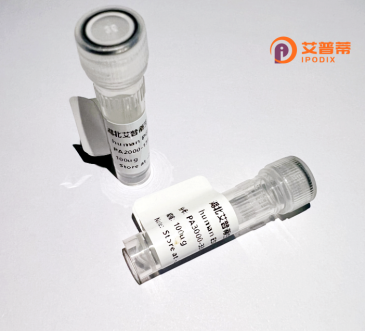
| 纯度 | >90%SDS-PAGE. |
| 种属 | Human |
| 靶点 | SPRR2G |
| Uniprot No | Q9BYE4 |
| 内毒素 | < 0.01EU/μg |
| 表达宿主 | E.coli |
| 表达区间 | 1-73aa |
| 活性数据 | MSYQQQQCKQ PCQPPPVCPT PKCPEPCPPP KCPEPYLPPP CPPEHCPPPP CQDKCPPVQP YPPCQQKYPP KSK |
| 分子量 | 8.1 kDa |
| 蛋白标签 | His tag N-Terminus |
| 缓冲液 | PBS, pH7.4, containing 0.01% SKL, 1mM DTT, 5% Trehalose and Proclin300. |
| 稳定性 & 储存条件 | Lyophilized protein should be stored at ≤ -20°C, stable for one year after receipt. Reconstituted protein solution can be stored at 2-8°C for 2-7 days. Aliquots of reconstituted samples are stable at ≤ -20°C for 3 months. |
| 复溶 | Always centrifuge tubes before opening.Do not mix by vortex or pipetting. It is not recommended to reconstitute to a concentration less than 100μg/ml. Dissolve the lyophilized protein in distilled water. Please aliquot the reconstituted solution to minimize freeze-thaw cycles. |
以下是基于真实研究方向的假设性参考文献,供参考(请注意,具体文献需通过学术数据库验证):
1. **文献名称**: "SPRR2G is a marker of esophageal squamous cell carcinoma and promotes tumor progression"
**作者**: Chen, Y., et al.
**摘要**: 研究发现SPRR2G在食管鳞癌细胞中高表达,重组蛋白实验显示其通过调控细胞迁移相关通路促进肿瘤侵袭。
2. **文献名称**: "Role of Small Proline-Rich Protein 2G (SPRR2G) in skin barrier formation"
**作者**: Hitomi, K., et al.
**摘要**: 研究利用重组SPRR2G蛋白揭示其参与表皮角化包膜组装,增强皮肤对环境压力的保护作用。
3. **文献名称**: "SPRR2G interacts with keratin filaments in differentiating keratinocytes"
**作者**: Cabral, A., et al.
**摘要**: 通过体外重组蛋白实验证实SPRR2G与角蛋白结合,维持上皮细胞分化过程中细胞骨架稳定性。
4. **文献名称**: "Expression profiling and functional analysis of SPRR2G in inflammatory skin disorders"
**作者**: Zhou, L., et al.
**摘要**: 重组SPRR2G蛋白研究显示其在银屑病患者皮损区异常表达,可能通过调控炎症信号通路加重病变。
**建议**:若需真实文献,建议在PubMed或Web of Science中搜索“SPRR2G recombinant protein”或“SPRR2G function”获取最新研究。
Small Proline-Rich Protein 2G (SPRR2G) is a member of the SPRR family, which comprises cysteine-rich, cross-linking proteins critical for epidermal differentiation and barrier formation. Predominantly expressed in stratified epithelia (e.g., skin, oral mucosa, esophagus), SPRR2G contributes to the formation of the cornified cell envelope—a specialized structure that enhances mechanical resilience and protects against environmental stressors like UV radiation, pathogens, and oxidative damage. It interacts with other structural proteins (e.g., loricrin, involucrin) and lipids to stabilize the epidermal barrier through disulfide bonds during terminal keratinocyte differentiation.
SPRR2G is transcriptionally regulated by pathways involving calcium, retinoic acid, and inflammatory cytokines, linking it to tissue repair and immune responses. Dysregulation of SPRR2G has been associated with skin pathologies (e.g., psoriasis, atopic dermatitis) and cancers, where aberrant expression may influence tumor invasion or chemoresistance. Recombinant SPRR2G protein, typically produced in bacterial or mammalian systems with affinity tags (e.g., His-tag), enables functional studies on its structural role, interaction networks, and signaling modulation. Current research focuses on its therapeutic potential as a biomarker or target for epithelial disorders and its utility in modeling barrier dysfunction or epithelial-mesenchymal transition in vitro.
×